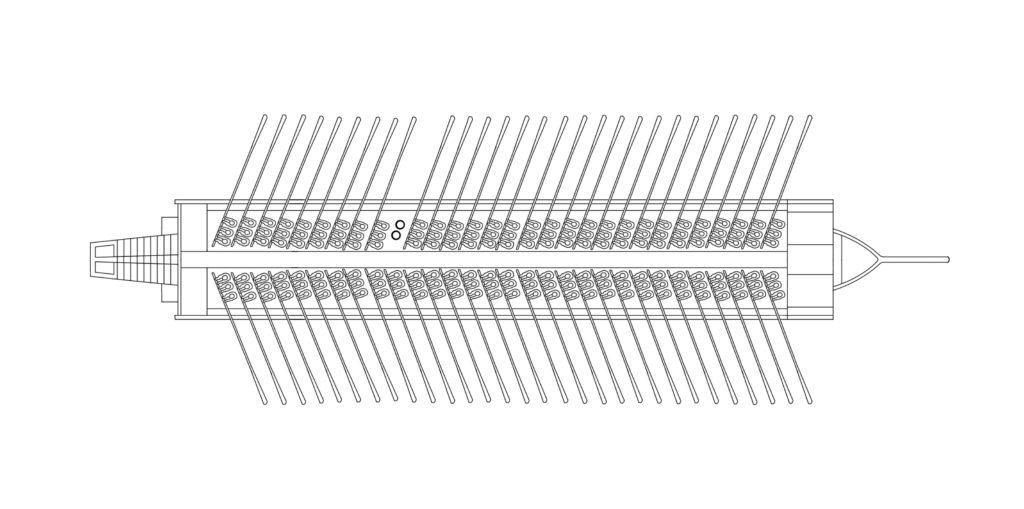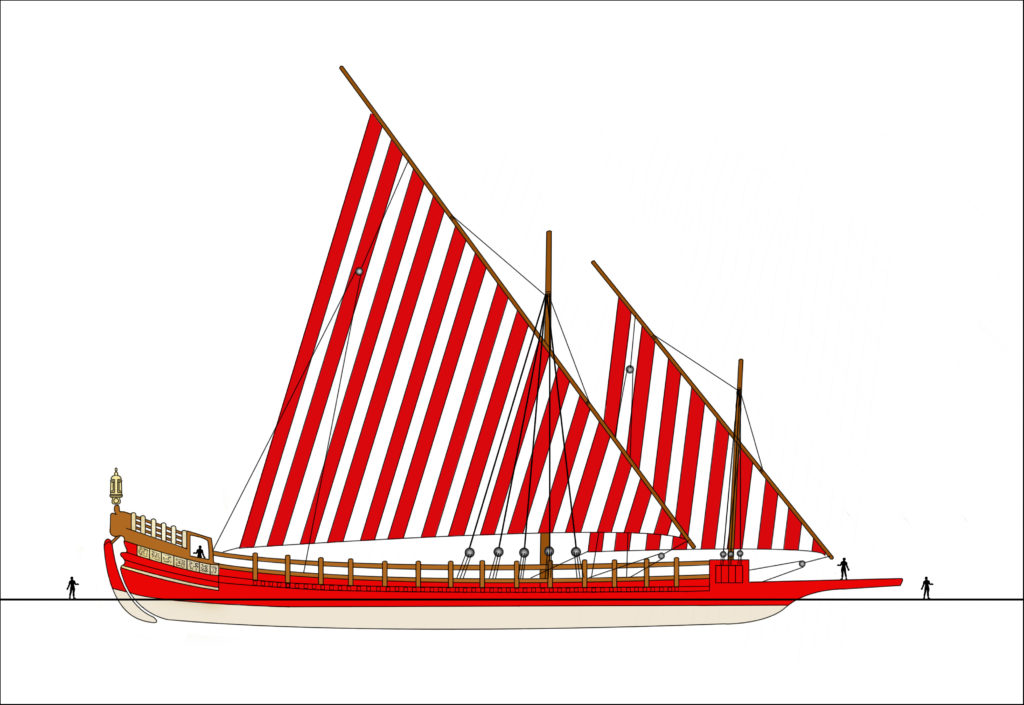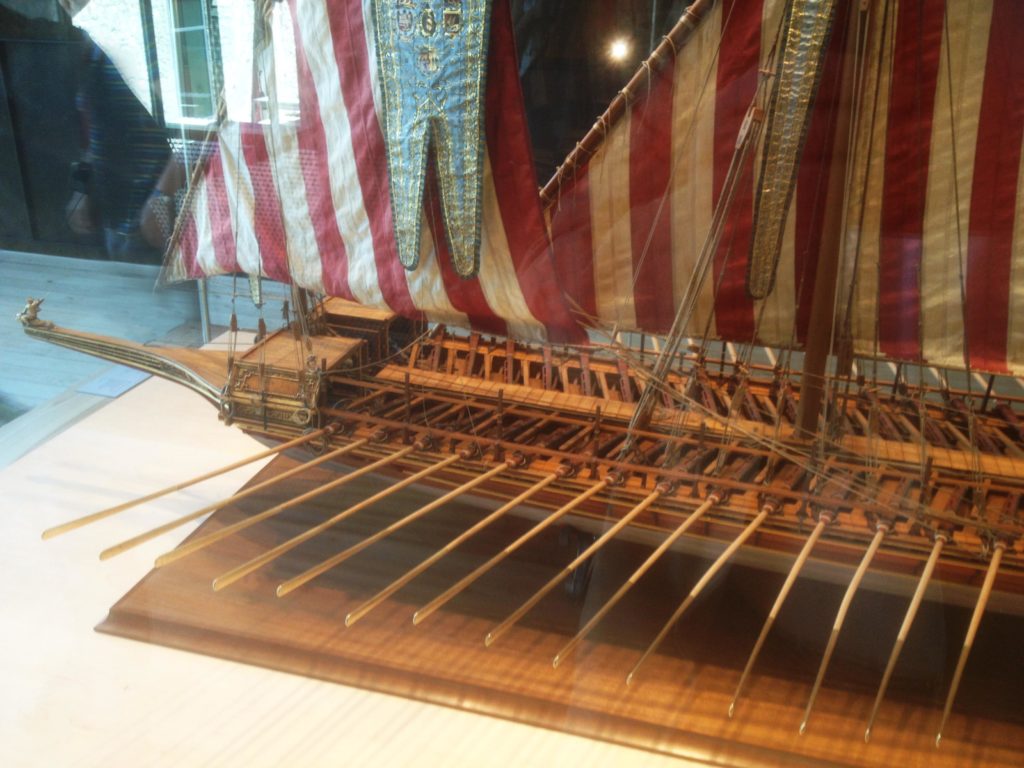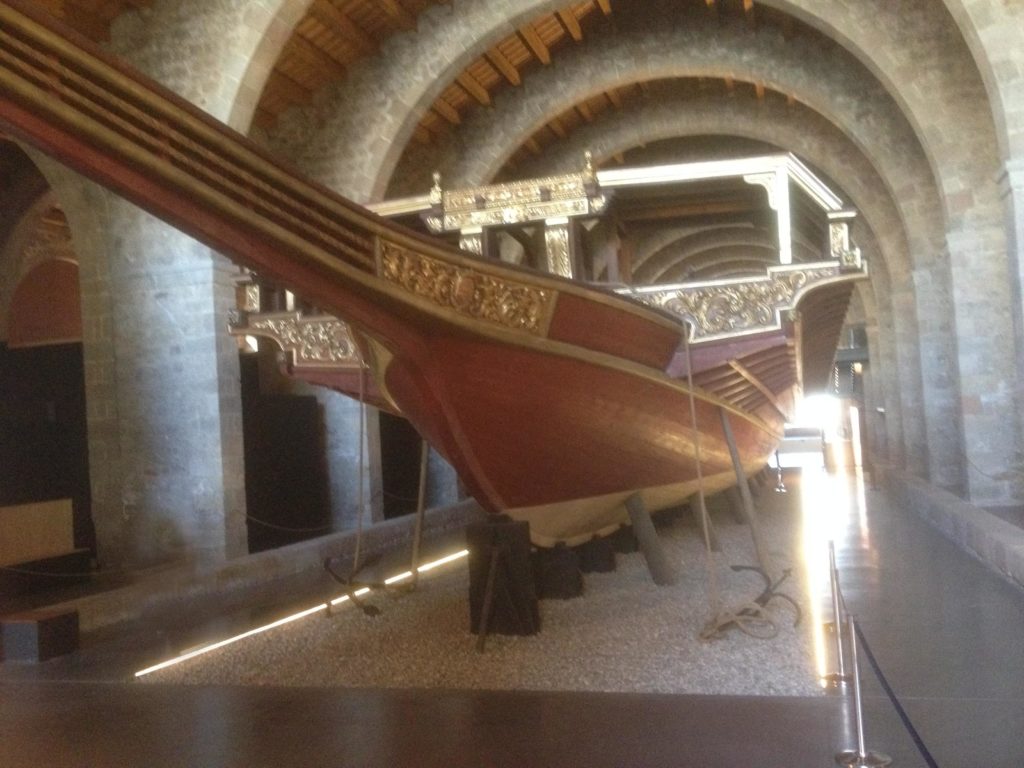(This post is a continuation of Oared Galleys – The Story of La Real: Part 1. If you haven’t done so already, it’s best to read that post before reading on here.)
La Real, the flagship galley that Don Juan commanded in the Battle of Lepanto, was a brand new ship, built only three years before in 1568.
For the times, it was a big vessel, about 200 feet/60 meters long and about 20 feet/6 meters) wide, with thirty banks of oars along each side. It had lateen sails (the word “lateen” derives from the French “latine,”meaning “Latin,” since such sails date back to Roman times). Lateen sails were triangular (rather than square) and hung from the mast at an angle of 45 degrees. La Real had two masts, the mainmast, about 72 feet/22 meters high, and a foremast about 50 feet/15 meters high, each with its respective lateen sail. You can see how all this looked in the image above—a photo of a model of La Real that is on display in the Barcelona Maritime Museum.
You can get a clearer sense of the ship, perhaps, from the image below, which not only gives the general contours of the vessel but also includes human figures to provide a sense of scale (the horizontal black line represents the waterline).
La Real was a warship. It carried a compliment of five cannons: a single heavy piece that fired a cannon ball about 6½ inches in diameter that weighed 36 pounds (16 kilograms), two that fired cannon balls about 4 inches in diameter that weighed 8 pounds (3.5 kilograms), and two that fired cannon balls about 3 ½ inches in diameter that weighed 6 pounds (2.7 kilograms). All these guns were located in the prow, facing forwards—with the sides of the ship dedicated to housing the oars, it was impossible to mount cannons along the gunwales, as was done with square-rigged sailing ships. When La Real attacked, it attacked forwards.
There were thirty banks of oars along each side (minus one, for one bank was replaced by the ship’s stove). These oars were about 30 feet/10 meters long and were heavy enough to require three men to operate them. The oarsmen didn’t sit while they were rowing. The oars were far too large. At the upper part of the stroke, when the oarblades were digging into the water, the oarsmen had to mount specially constructed benches. At the lower part of the stroke, when the oarblades were out of the water and being swung round for the next stroke, the oarsmen stepped back down from those benches—and then repeated that step-up/step-down process over and over again, in tandem, for anything up to eight or ten hours or more at a stretch sometimes.
You can see the step-up benches quite clearly in the photo below. The slim upright posts along both gunnels are the oarlocks. There are two sets of rowing benches, with a gangway running transversely between them. This gangway, which ran almost the entire length of the ship, was used to move men and supplies back and forth. It was also used by those overseeing the oarsmen to either lash them into further efforts of offer them food (hardtack biscuits) and drink (water mixed with a little vinegar). You can also make out the ship’s stove (in the top left of the image), which replaced one of the oars.
Galleys were odd looking vessels. Imagine a very long, skinny boat—like a racing shell, the modern competitive rowing boat—but with a flat platform laid across the gunwales, so that when you look down on it from above, the vessel appears to be a long rectangle with the prow sticking out at the front and the stern at the back. This platform was what enabled the oars—and the oarsmen—to fit into the hull of the ship. You can see the set-up in the drawing below:
The bow of La Real, like the bows of all such European galleys, consisted of a long ‘beak’ behind which sat the forecastle. This housed the forward-pointing cannons and served as a deck to mass soldiers when attacking enemy ships. The image below (another shot of the model in the Barcelona Maritime Museum) shows the prow of the ship as seen from the port side.
Here’s a shot of the prow of the actual (recreated) ship on display in the Barcelona Maritime Museum, as seen from the ground. You can make out the beak, the rectangular (gilded) forecastle, and the framing for the platform that contains the oarbenches and oarsmen.
At the rear end of the ship was the sterncastle. The captain commanded the ship from here, and it was here that other important persons—like Don Juan himself—spent their time.
La Real was a warship. But it was also a splendid work of art. Since the sterncastle was the place where all the important people stayed, it was the most decorated part of the ship. The decoration was of a baroque opulence, with gilded base-relief carvings, statuary, and paintings. Below, you can see a photo of the decorations along the port side of the sterncastle.
The back end of the sterncastle sported three lanterns and yet more elaborate decoration. Below is a photo.
The actual sixteenth century La Real was likely less ostentatiously opulent than the replica—less gilding, less paint—but in its day it would nonetheless have been a spectacular sight. For modern sensibilities, though, it presents an ugly contrast. On the one hand, there is all that extravagant beauty. La Real represented not only the power and wealth of the Habsburgs; it was a floating gallery of fine art. On the other hand, it was a cesspit of human misery, powered by slave labor.
This was a contrast that, at the time, people apparently accepted without much thought. It was just the way things worked.
Makes you wonder about human nature.

Corsairs and Captives
Narratives from the Age of the Barbary Pirates
View Amazon listing
The Travels of Reverend Ólafur Egilsson
The story of the Barbary corsair raid on Iceland in 1627
View Amazon listing





